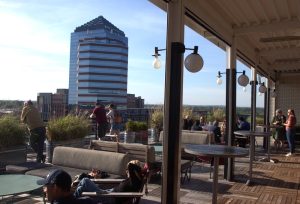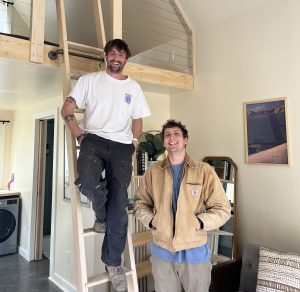The smell of Auntie Anne’s, once unavoidable, is canceled out by the scent of a lemony floor cleaner. Masked shoppers exchange gentle, knowing looks. In the stores and at the kiosks, cashiers attempt to look approachable behind clear plastic register shields. Customers in line to check out are instructed where to stand by stickers marking 6-foot distances. This is Southpoint mall as Durham begins to reopen.
In the past two months of the COVID-19 pandemic, beer-loving Durhamites have been enjoying their brews on their front porch, rather than with a game of cornhole at Ponysaurus or Stand-up Comedy at Durty Bull. As the city, along with many parts of the country, move through the phases of reopening, the hiss of a beer can be heard further and further from home — on the East Campus lawn or at Old North Durham Park. But these familiar outings look different, transformed by the social distance dance we all must do as we adapt to the World with the Virus.
A stroll through the Streets at Southpoint offers a concentrated look at the choreography of this emerging reality. The parking lot, usually buzzing with shoppers hoping to capitalize on Memorial Day sales, has the feel one might expect during a midday visit on a Tuesday. In the quiet lot the dance begins: Is it alright to park right next to another car? Is that violating social distance etiquette? And walking in: Is it still polite to hold the door open for the person behind you?
To amble around Southpoint is to do this awkward dance, a once-ordinary walk transformed into navigating a minefield that might hide an invisible disease. A pair of teens joke about crossing the tape line of the boarded-up massage chairs outside Macy’s, but they respectfully step to their right as another shopper comes into their radius. This is the dance. Couples share nervous glances when strangers get too close, but everyone works together to pretend at normalcy, making nonchalant conversation with their gloved cashiers as we shift into our new roles as mask-wearers and social distancers.
A smattering of the stores have made the decision to open up and the new summer collections are the least of their changes. Hollister now requires masks to enter; Aerie gives them away; Macy’s has hand sanitizer stations at the entrances. Urban Outfitters has gone so far as to tape arrows on the floor to provide shoppers with a suggested path, taking you from room decor to hair accessories, to promote social distancing.
The open retailers skew younger: Forever 21 and H&M. Pink, marketed toward young adults, is still closed, but Talbots, popular with middle-aged women, is in business.
There’s no skew to the shoppers. People of all ages wander the mall. Almost everyone travels in pairs; masks muffle the conversation, which makes the place quieter than usual.
“This area is for sitting, not eating,” reads a paper sign taped to the Streets’ patio furniture. “This too, shall pass,” it adds.
The sign hints at a return to normalcy, but that day is probably a long way in the future. Restaurants have shifted primarily to pick-up options. Food court favorites like Built (Custom Burgers) and Pholicious are open, but there’s not really any place to sit.

The dark storefronts have paper signs with vague explanations and a little hope. The AMC Theatre says it is closed “today,” apologizing for the “inconvenience.” Bath & Body Works stresses the safety of their employees in the decision.
What’s next for these stores? Will they open their doors again soon? Or fold like so many seemingly impenetrable companies taken down by the virus (JCPenney has filed for bankruptcy, while Pier 1 is closing all of its 540 stores)? Are they really holding back out of safety concerns? Financial difficulties? How are their workers holding up without the income? It seems these answers will not be available until “further notice.”
The mall, like Durham, is in a state of transition. The tables at the food court are cordoned off and the fountain outside the movie theatre is drained, like a lake after a drought. But even so, people are puttering about — attempting to make sense of it all. There is an eeriness to this new world and a guilt to participating in it. How essential is this trip? Who am I putting at risk by making it? These questions lead to the bigger one hanging above Durham, palpable in public spaces like this: Are we ready for Phase 2?
In photo above, seating in the food court has been moved to discourage seating. Photo by Carmela Guaglianone | The 9th Street Journal





